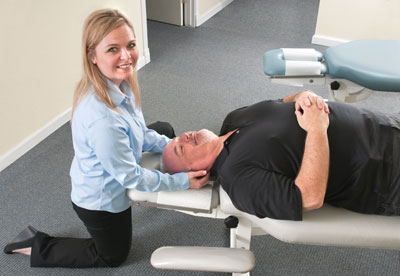
To be a chiropractor means we are automatically put in a leadership position whether we like it or not.
To be a chiropractor means we are automatically put in a leadership position whether we like it or not. Sometimes, being a good leader means you need to step back from your practice and look at the big picture. I read an article in the January 2, 2012, issue of the Globe and Mail called “Leadership: Thinking in Threes. This article was addressed to anyone who might be in a leadership role and posed three great questions that are very applicable for us as chiropractors.
 |
|
| It is vital we learn new techniques, or fine-tune current techniques, to serve different body and personality types. Advertisement
|
Question 1
What are the three things that we do that tick off our customers, and what will we do to eliminate these irritants?
Let me begin by mentioning that the easiest way to find out what “ticks off” our patients is to do a focus group. One of the better templates that I have seen for holding focus groups comes to us from Bill Esteb. You can find his free guide on his website (patientmedia.com). It is always hard to hear negative feedback, but this information is very valuable to growing your practice.
When I ask patients about previous experiences with chiropractors, there are three main areas that tend to tick them off. They include poor bedside manner and adjusting techniques, long wait times and unfriendly staff.
How can we improve on these main areas to serve our patients better?
It is vital that we learn new alternative techniques or even “fine tune” our techniques so we can serve many different body and personality types. Secondly, it is important to try and keep the patient’s total time in the office under twenty minutes, no matter what style of practice you have. Being constantly behind, or unaware of time, can be annoying and rude to our patients who are living in an increasingly busy society. Last, I can’t tell you enough, how important it is to have the right person sitting at your front desk who is friendly, well-trained and happy with their career.
Question 2
What three extraordinary things could we do to make doing business with us not all about price?
Start with being a great listener! It may sound silly, but if done properly, this will make the patient feel validated and sometimes is worth more to them than the adjustment.
Secondly, go the extra mile and give them something above and beyond a treatment, possibly some at-home exercises or the latest research article that is pertinent to them. If you are going to do this be sure to follow up with them. There is nothing worse than giving something to someone and then not caring enough to ask if they are doing the exercises or if they reviewed the article.
Last, remembering and celebrating patients’ important days and events can go a real long way to making their experience with you not all about price! Acknowledging things like birthdays, anniversaries, births and new jobs, just to name a few, can really bring the patient’s experience to a level well beyond a “business transaction.”
Question 3
What are the three things we can do to sharpen internal communication aimed at improving clarity about our commitments to patients, to our staff and to the bottom line?
Three of the best ways to improve communication with our staff is to have regular huddles, weekly meetings and professional development days. A huddle can be performed easily at the end of the morning shift and again at the end of the day to discuss anything that did not work, and more importantly the things that worked really well. In addition, you should be having at least one meeting a week (an hour will do) where ideas, tasks, and patients’ care can be discussed in more detail. Last, professional development days can be done as often as bi-monthly. Shut the office down and spend the day working on bigger projects. Here is where you can share bigger visions and goals that will guide the office in taking better care of your patients. You may even choose to do something fun, as well, on these days. Get out of the office and go bowling or rock climbing, and end it with a nice dinner. This is a great time to have fun and bond
together as a team.
I hope these simple questions will allow you to take a step back from your practice and give you some great ideas to work on in the future. As I have mentioned before, it is important that once you have some ideas on paper, you turn them into action steps with the appropriate deadlines.
Remember, when it comes to your practice, work from the inside out!
| Key to self-evaluating to Improve your practice: Being a good leader means you need to step back from your practice and look at the big picture. Action Step 1: Run a focus group or do a self-evaluation of your practice. Action Step 2: Brainstorm some ways you can make patients feel special in your office. Action Step 3: Reconnect with your staff by having regular huddles, meetings and professional development days. |
Dr. Angelo Santin is a 2006 graduate of the CMCC. He operates a busy subluxation-based family practice in Thunder Bay, Ont., and is currently serving his second year as president of the Thunder Bay Chiropractic Society. Dr. Santin is one of a small number of international proficiency-rated chiropractic coaches, and draws on his success, along with the experience of the most renowned experts in this field, to provide time-tested, effective and patient-centred ideas for every chiropractor. He can be reached at angelosantin@gmail.com or 807-344-4606.
Print this page